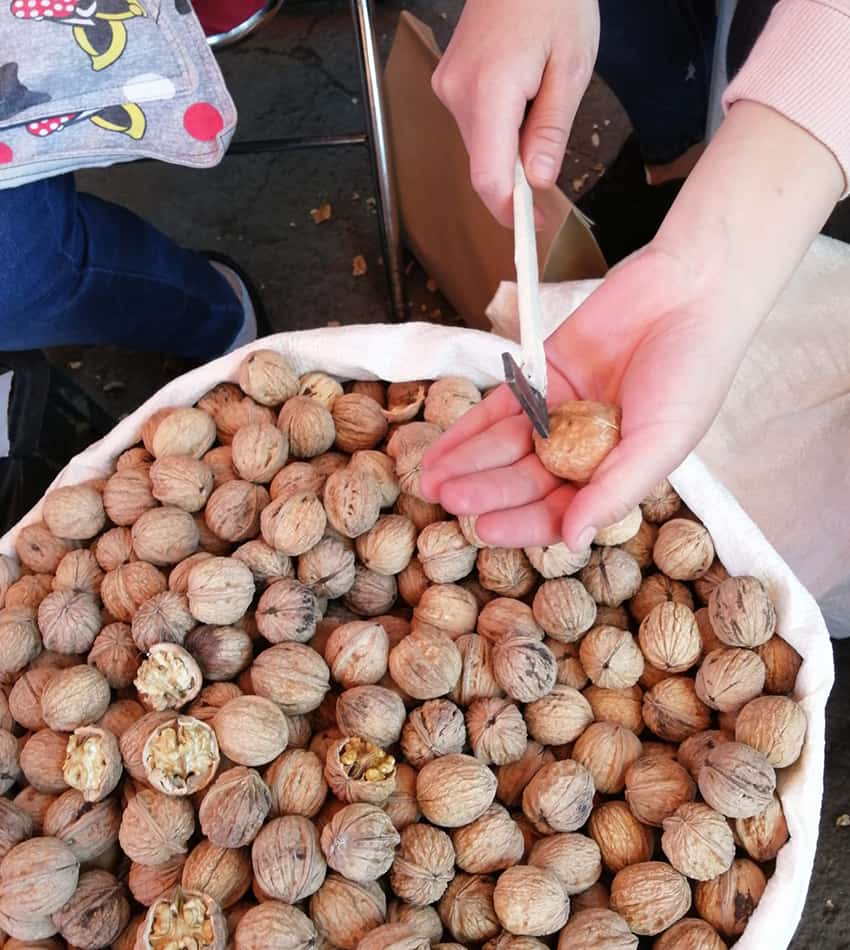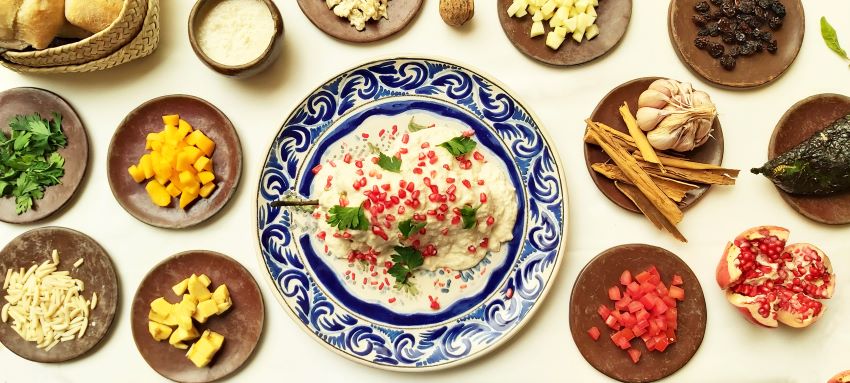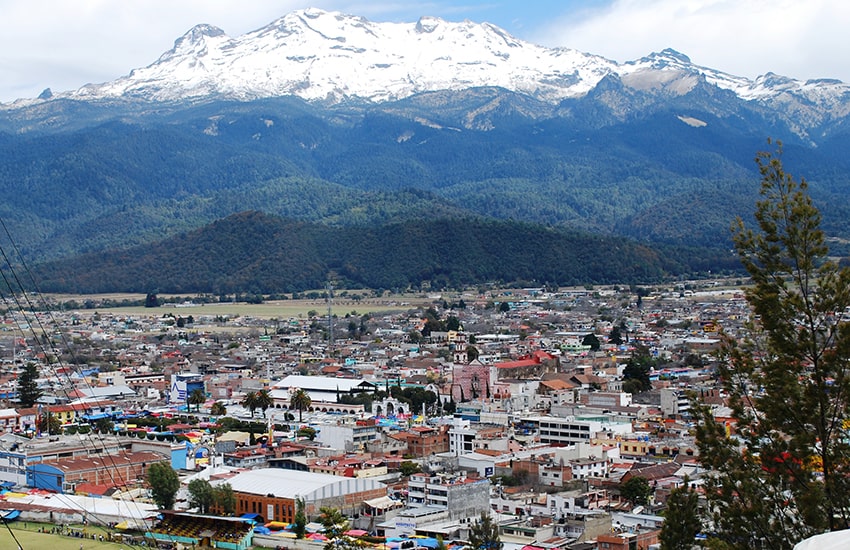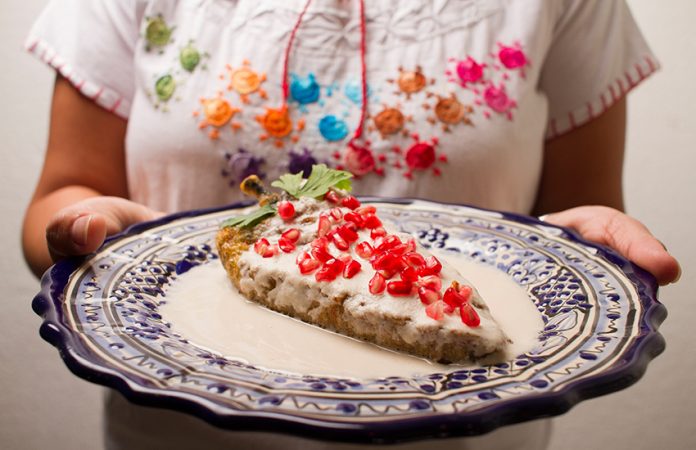Chiles en nogada, Mexico’s traditional Independence Day dish, may be the nation’s only case where one particular crop is almost exclusively dedicated to one particular food preparation.
If you live in the areas around Mexico City and Puebla, you probably see individuals at markets, tap-tapping away at walnuts, carefully displaying the half-exposed meats in their baskets. This is your first cue that walnuts are, indeed, a luxury item, more expensive than even macadamias.
As such, the fresh meats are carefully selected to go in chile en nogada (chile pepper in walnut sauce), a dish available only from late July through September.
The origin of the dish is somewhat disputed, but the most accepted story is that it was invented by nuns of the Santa Monica convent in Puebla city in 1821. The occasion was the arrival of Agustín de Iturbide, soon to become Mexico’s first emperor, and his Army of the Three Guarantees.
The War of Independence was nearing its end when he arrived at the convent. Using what they had from their gardens in late summer, the nuns stuffed roasted poblano peppers, covered them in a delicate sauce made from cheese and ground fresh walnuts, then sprinkled the dish with pomegranate seeds.

The effect was to mimic the green, white and red of the flag of this army, which would be the basis of the flag of independent Mexico.
The most traditional preparations of chile en nogada stay true to those ingredients common in Puebla in late summer: panochera apples, de leche pears, criollo peaches and the walnuts that gave the dish its name.
It is an unusual dish for Mexico, sweet and not spicy in the least. At least one source claims that the dish began as a dessert, with ground pork added to the stuffing later.
It is now so strongly associated with celebrations of Mexico’s independence that it seems almost unpatriotic to make changes to it, even if said changes would make the dish available year-round or more economical.
There has been some experimentation, substituting other nuts like pecans, almonds or macadamias in the sauce and using dried cranberries for the pomegranates, but these efforts are often met with derision.
The insistence on pomegranate seeds and fresh walnuts keeps chile en nogada a specialty, highly seasonal and rather expensive dish by Mexican standards. (It should be noted that if you find the dish at a significantly lower price, there is a very good chance real walnuts were not used.)

The Spanish introduced both ingredients to Mexico. Pomegranates grow fairly widely in the center of the country and in some northern areas, but walnut production is almost exclusive to the slopes of the Iztaccihuatl and Popocatépetl volcanoes, which separate the states of Puebla and México.
Archaeologist Eduardo Merlo established that the first walnut trees were planted in 1539 at a Franciscan monastery in the small town of Calpan, Puebla, which calls itself Mexico’s “walnut cradle.” Today, almost all of Mexico’s walnuts are grown on these iconic volcanic slopes because of their climate.
There are an estimated 60 producers in this region, with over 3,000 families dependent on the crop in some way. Both Puebla and México state claim to produce the most, but what is clear is that the majority of this crop winds up in chiles en nogada one way or another.
About a third are sold directly to restaurants, another third to events dedicated to the dish and the rest to traditional markets. The dish is most popular in central Mexico, but it is fairly common in restaurants in tourist and major metropolitan centers such as Acapulco, Baja California and Monterrey.
The dish has always been important to Puebla as a seasonal tourist attraction. In 2011, the state created the largest chile en nogada in the world. With the help of 2,000 people, restaurants in Atlixco layered 1,800 poblanos in a mold to create a dish that measured 1.5 meters long and 60 cm wide.
This year marks the 200th anniversary of the dish, and the state of Puebla is taking advantage of this to promote it with events both in Mexico and the United States this summer. Despite the pandemic, Puebla tourism officials hope to sell well over 3.5 million chiles en nogada statewide, beating the 3.1 million sold in 2019.

Festivals dedicated to the dish are popular in Puebla and México state in August and September. These fairs were canceled in 2020 but were green-lighted this year with limited capacity and other restrictions. As of this writing, the national coronavirus stoplight map shows Puebla at yellow and México at orange. According to various municipalities, their fairs are still on, but checking with authorities online or by telephone is recommended before you attend.
The main fairs celebrating chile en nogada and walnuts in Puebla are held in Calpan and San Nicolás de los Ranchos.
Calpan’s fair is scheduled for September 1–15. In San Nicolás, the festival will occur during the weekends of August, starting on August 7.
The main fair in México state is held in Amecameca. The Walnut and Mushroom Fair takes place August 7–15. It includes a chile en nogada-making contest. Other regional dishes will be available as well. Wild mushrooms are also in season at this time and are also very much worth tasting.
These fairs and participating producers try to promote the making and selling of walnuts in other preparations, in particular liquors and baked goods, but by far, chile en nogada remains the king.
Leigh Thelmadatter arrived in Mexico 18 years ago and fell in love with the land and the culture in particular its handcrafts and art. She is the author of Mexican Cartonería: Paper, Paste and Fiesta (Schiffer 2019). Her culture column appears regularly on Mexico News Daily.
